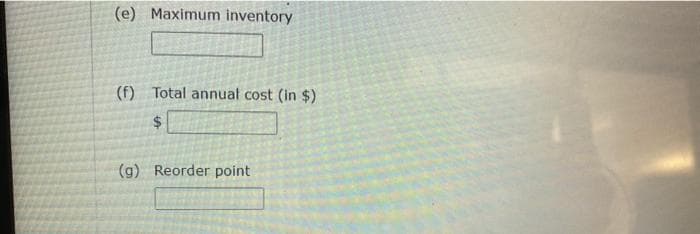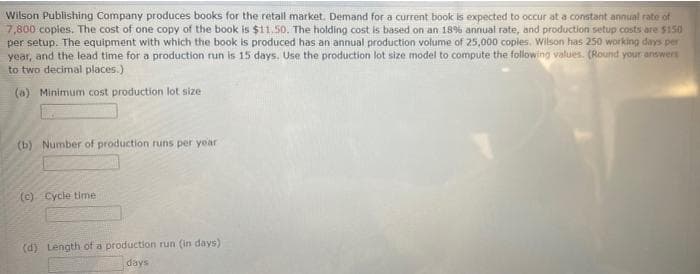(e) Maximum inventory (f) Total annual cost (in $) (g) Reorder point
Purchasing and Supply Chain Management
6th Edition
ISBN:9781285869681
Author:Robert M. Monczka, Robert B. Handfield, Larry C. Giunipero, James L. Patterson
Publisher:Robert M. Monczka, Robert B. Handfield, Larry C. Giunipero, James L. Patterson
Chapter16: Lean Supply Chain Management
Section: Chapter Questions
Problem 10DQ: The chapter presented various approaches for the control of inventory investment. Discuss three...
Related questions
Question

Transcribed Image Text:(e) Maximum inventory
(f) Total annual cost (in $)
$
(g) Reorder point

Transcribed Image Text:Wilson Publishing Company produces books for the retail market. Demand for a current book is expected to occur at a constant annual rate of
7,800 copies. The cost of one copy of the book is $11.50. The holding cost is based on an 18% annual rate, and production setup costs are $150
per setup. The equipment with which the book is produced has an annual production volume of 25,000 copies. Wilson has 250 working days per
year, and the lead time for a production run is 15 days. Use the production lot size model to compute the following values. (Round your answers
to two decimal places.)
(a) Minimum cost production lot size
(b) Number of production runs per year
(c) Cycle time
(d) Length of a production run (in days).
days
Expert Solution
This question has been solved!
Explore an expertly crafted, step-by-step solution for a thorough understanding of key concepts.
Step by step
Solved in 3 steps

Recommended textbooks for you

Purchasing and Supply Chain Management
Operations Management
ISBN:
9781285869681
Author:
Robert M. Monczka, Robert B. Handfield, Larry C. Giunipero, James L. Patterson
Publisher:
Cengage Learning

Purchasing and Supply Chain Management
Operations Management
ISBN:
9781285869681
Author:
Robert M. Monczka, Robert B. Handfield, Larry C. Giunipero, James L. Patterson
Publisher:
Cengage Learning